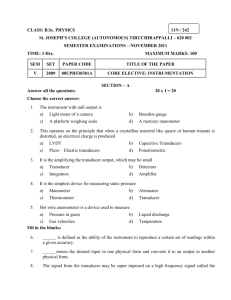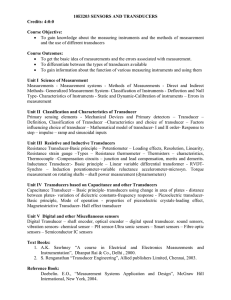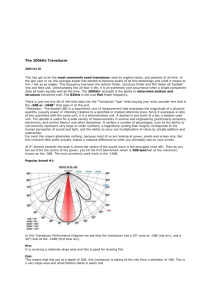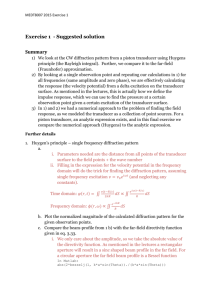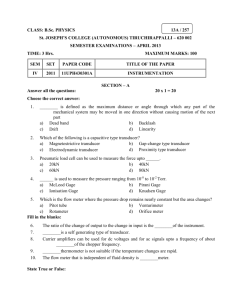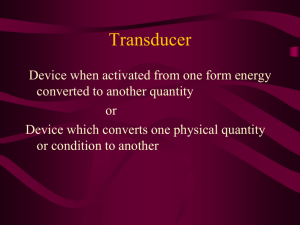Transducer Characterization
advertisement
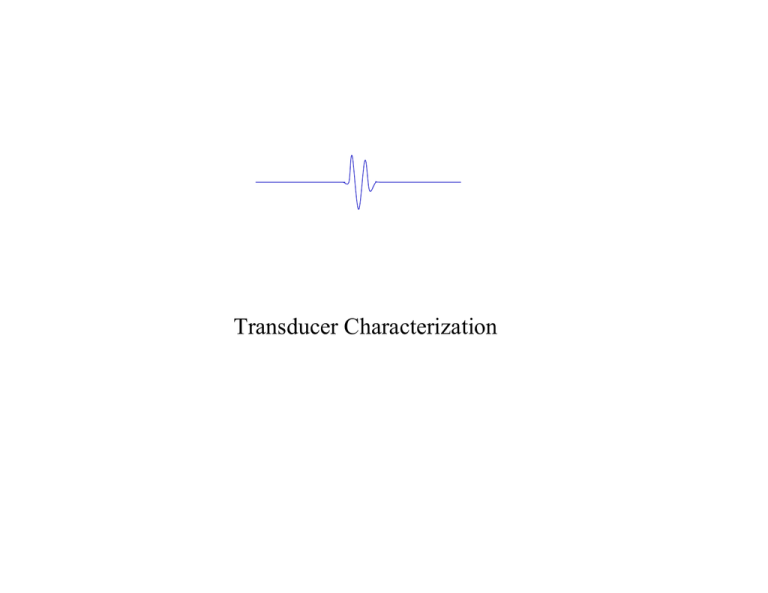
Transducer Characterization Learning Objectives Pulse-echo experimental determination of impedance, sensitivity of commercial transducers Experimental determination of effective radii and focal lengths of commercial transducers Transducer impedance, sensitivity Ft (ω ) Z rA;a SvIA tG (ω ) = = A; e Vi (ω ) ( Z in T11 + T12 ) + ( Z inA;eT21 + T22 ) Z ie VR (ω ) K Z oe SvIB = B ;e t R (ω ) = FB (ω ) ( Z in R11 + R12 ) + ( Z inB ;e R21 + R22 ) Z oe To fully characterize these generation and reception transfer functions, we need to be able to obtain the transducers input electrical impedance and their sensitivities Transducer impedance Measurement of the transducer input impedance, Zin : Current probe I Pulser V Short cable Transducer water V Zin = I Transducer impedance Example impedance measurements of two 5 MHz transducers: transducer 1 1500 150 130 1000 120 amplitude 110 phase 500 100 90 0 0 5 10 Frequency (MHz) 15 80 20 Phase (Deg) Amplitude (Ω) 140 Transducer impedance transducer 2 1500 150 130 1000 120 110 amplitude 500 phase 100 90 0 0 5 10 Frequency (MHz) 15 80 20 Phase (Deg) Amplitude (Ω) 140 Transducer impedance Impedance of a capacitor, Z =1/(-iωC) 8 91 6 90.5 magnitude 4 90 2 0 0 89.5 1 2 3 4 5 6 frequency 7 8 9 89 10 phase Transducer sensitivity Pulse-echo measurement setup for determining sensitivity pulser/receiver ρ1 , c p1 solid D Transducer sensitivity 1. measure voltage and current when transducer is radiating into the fluid but before any reflected waves have arrived v1 ( t ) , i1 ( t ) a ρ1 , c p1 b solid D Transducer sensitivity 2. do FFT of the measured voltage and current and relate to the voltage and current at the transducer by compensating for the cabling I1 (ω ) V1 (ω ) I in (ω ) [ T] vt = SvIA I in Vin (ω ) Z inA;e ⎧Vin ⎫ 1 ⎡ T22 −T12 ⎤ ⎧V1 ⎫ ⎨ ⎬= ⎢ −T ⎥ ⎨I ⎬ T I det T [ ] 11 ⎦ ⎩ 1 ⎭ ⎣ 21 ⎩ in ⎭ A; e Note: then the impedance of the transducer is just Z in = Vin I in Transducer sensitivity 3. measure voltage and current generated by the waves reflected from the surface of the block: v2 ( t ) , i2 ( t ) a ρ1 , c p1 b solid D Transducer sensitivity 4. do FFT of the measured voltage and current and relate to the voltage and current at the transducer electrical port by compensating for the cabling Z inA;e IT (ω ) SvIA FB VT (ω ) I 2 (ω ) [ T] V2 (ω ) ⎧VT ⎫ 1 ⎡ T22 −T12 ⎤ ⎧V2 ⎫ ⎨ ⎬= ⎢ −T ⎥ ⎨I ⎬ T I − det T [ ] 11 ⎦ ⎩ 2 ⎭ ⎣ 21 ⎩ T⎭ Transducer sensitivity 5. From these measurements and a knowledge of the acoustic/elastic transfer function for this setup we can obtain the sensitivity of the transducer from: SvIA = Vin IT + VT I in t A Z rA;a I in2 [Note: in all these division processes in the frequency domain, a Wiener filter is used to desensitize the process to noise] Transducer sensitivity Example sensitivity calculated for a 5MHz planar transducer: 0.35 100 0.3 50 0.25 0.2 -50 0.15 Phase (deg) Amplitude (V/N) 0 -100 0.1 -150 0.05 0 0 5 10 f (MHz) 15 -200 20 Transducer sensitivity Cabling effects need to be accounted for in determining the sensitivity: Amplitude (V/N) 0.3 Compensation No compensation 0.2 0.1 0 0 5 10 f (MHz) 15 20 0 5 10 f (MHz) 15 20 Phase (deg) 400 200 0 -200 Transducer Effective Parameters Use of manufacturer specifications for parameters such as transducer radius and focal length in transducer models do not always lead to good agreement with experimental measurements. a R0 Thus, we need to determine experimentally "effective" values for these parameters. Transducer Effective Parameters Effective radius for an unfocused (piston) immersion probe sample FFT z 5 MHz 2 plot 5 MHz component versus z 1.8 |p| ρcv0 1.6 1.4 1.2 1 find zmin 0.8 0.6 determine aeff 0.4 0.2 0 zmin 0 0.5 1 1.5 2 z/N 2.5 3 3.5 4 aeff = 2λ zmin Transducer Effective Parameters Effective radius and focal length for a spherically focused probe 12 aeff = 10 zmax 2λ zmin ( R0 )eff ( R0 )eff − zmin 8 |p| ρcv0 ( R0 )eff 6 4 ⎧⎪ ⎫⎪ π −x = zmax ⎨ ⎬ ⎪⎩π − x ( zmax / zmin ) ⎭⎪ 2 where x is the root of: 0 0 zmin 0.5 1 1.5 2 2.5 3 3.5 4 π − x ( zmax / zmin ) sin ( x ) x cos ( x ) = π −x Transducer Effective Parameters Effective transducer parameters determined experimentally: Probes Manufacturers Specs focal length radius (cm) (cm) Estimated Parameters Center focal length radius Frequency (cm) (cm) (MHz) A 7.62 0.476 13.47 0.451 10 B 7.62 0.635 20.74 0.556 5 C 7.62 0.476 7.45 0.469 15 These values should be independent of frequency but in practice they do vary somewhat with the frequency component used in their determination.


